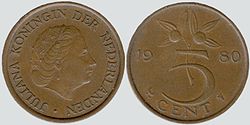NLG发表评论(0)编辑词条
Dutch guilder
The guilder (the symbol ƒ or fl., code is NLG) was the currency of
the Netherlands from the 17th century until 2002, when it was replaced by the euro. Between 1999 and 2002, the guilder was officially a "national subunit" of the euro. However, physical payments could only be made in guilder, as no euro coins or banknotes were available. Guilder are still in use in the Netherlands Antilles, a Dutch dependency, although this currency is distinct from the Dutch guilder. In 2004, the Surinamese guilder was replaced by the Surinamese dollar.
The Dutch name gulden was a Middle Dutch adjective meaning "golden",and
the name indicates the metal the coin was originally made of gold. The symbol ƒ or fl. for the Dutch guilder was derived from another old currency, the florijn.
The exact exchange rate, still relevant for old contracts and for exchange of the legacy currency for euros at the central bank, is 2.20371 Dutch guilders (NLG) for 1 euro (EUR). Inverted, this gives EUR 0.453780 for NLG 1.
Coins
In the 18th century, coins were issued by the various provinces. There were copper 1 duit, silver 1, 2, 6 and 10 stuivers, 1 and 3 guilder, ½ and 1 rijksdaalder and ½ and 1 ducaton. Gold 1 and 2 ducat trade coins were also minted. Between 1795 and 1806, the Batavian Republic issued coins in similar denominations to the earlier provincial issues. The Kingdom of Holland minted silver 10 stuiver, 1 florin and 1 guilder (equivalent), 50 stuivers and 2½ guilder (also equivalent) and 1 rijksdaalder, along with gold 10 and 20 guilder. Before decimalisation, the Kingdom of the Netherlands briefly issued some 1 rijksdaalder coins.
The Gold 1 and 2 Ducat and Silver Ducat (rijksdaalder) are still minted today as bullion coins.
In 1817, the first coins of the decimal currency were issued, the copper 1 cent and silver 3 guilder. The remaining denominations were introduced in 1818. These were copper ½ cent, silver 5, 10 and 25 cents, ½ and 1 guilder, and gold 10 guilder. In 1826, gold 5 guilder coins were introduced.
In 1840, the silver content of the coinage was reduced (see above) and this was marked by the replacement of the 3 guilder coin by a 2½ guilder piece. The gold coinage was completely suspended in 1853, five years after the suspension of the gold standard. By 1874, production of silver coins greater in value than 10 cents had ceased, to be only fully resumed in the 1890s. Gold 10 guilder coins were struck again from 1875. In 1877, bronze 2½ cent coins were introduced. In 1907, silver 5 cent coins were replaced by cupro-nickel pieces. In 1912, gold 5 guilder coins were reintroduced but the gold coinage was ended in 1933.
In 1941, following the German occupation, production of all earlier coin types ceased and zinc coins were introduced for 1, 2½, 5, 10 and 25 cents. Large quantities of pre-war type, silver 10 and 25 cents and 1 guilder coins were minted in the United States between 1943 and 1945 for use following liberation.
Banknotes
Between 1814 and 1838, the Netherlands Bank issued notes in denominations of 25, 40, 60, 80, 100, 200, 300, 500 and 1000 guilders. These were followed, from 1846 by state notes (muntbiljetten) in denominations of 5, 10, 20, 50, 100, 500, 1000 guilders, with the 10 and 50 guilders issued until 1914.
In 1904, the Netherlands Bank recommenced the issuance of paper money. By 1911, it was issuing notes for 10, 25, 40, 60, 100, 200, 300
and 1000 guilders. In 1914, the government introduced silver notes (zilverbonnen) for 1, 2½ and 5 guilder. Although the 5 guilder were only issued that year, the 1 guilder notes continued until 1920 and the 2½ guilder until 1927.
In 1926, the Netherlands Bank introduced 20 guilder notes, followed by 50 guilder in 1929 and 500 guilder in 1930. These introductions followed the cessation of production of the unusual 40, 60 and 300 guilder notes during the 1920s.
In 1938, silver notes were reintroduced for 1 and 2½ guilders. During the Second World War, the Netherlands Bank continued to issue paper money, although there were some design changes, most notably, the replacement of a portrait of Queen Emma by a Rembrandt portrait on the 10 guilder note. The Allies printed state notes dated 1943 for use following liberation. These were in denominations of 1, 2½, 10, 25, 50 and 100 guilders. More state notes were issued for 1 and 2½ guilders in 1945 and 1949.
Following the war, the Netherlands Bank introduced notes for 10, 20, 25, 50, 100 and 1000 guilders. The last 20 guilder notes were dated 1955, whilst 5 guilder notes were introduced in 1966 (replaced by coins in 1987) and 250 guilder in 1985.
荷兰盾(Dutch Guilder(or Florin),Netherlands guilders,原符号:Gs.、Fl.、Dfl.、 Hfl.、fl.,标准符号:NLG)
荷兰货币简史
荷兰盾是荷兰王国的货币名称,由荷兰银行发行。1荷兰盾等于100分(Cents)。有5、10、25、50、100、250、1000盾的钞票,及1、2.5、5、10、 50盾和5、10、25分铸币。
荷兰盾于15世纪开始流通,2002年01月28日起荷兰本国货币荷兰盾全面停止使用。其中纸币于1999年停止流通,被欧元取代,硬币于2002年被欧元硬币取代,这是自2002年1月1日欧元流通以来欧元区国家第一种正式退出历史舞台的货币。但是荷兰盾在荷属安的列斯至今仍然流通。
关于荷兰的各种名称
英文中有关荷兰的三个词the Netherlands, Holland, Dutch 有何区别?
The Netherlands指荷兰,就象China指中国一样。
Holland也指荷兰,这是因为以前以北荷兰省和南荷兰省为主体的两个省构成了荷兰,这两个省在全世界以从事贸易闻名,久而久之,人们便以 Holland代指荷兰,但现在这两个省只是荷兰西部国土的一部分。
Dutch是指荷兰人,就象Chinese指中国人一样。Dutch也指荷兰语。
荷兰盾汇率
1946年12月18日,荷兰盾的含金量定为0.334987克,官方汇率为1美元等于 2.65285荷兰盾。1949年9月21日,荷兰盾贬值30.2%,含金量减为0.233861克,官方汇率为1美元兑3.80荷兰盾。1960年11 月1日,荷兰、比利时、卢森堡签订的经济联盟条约生效,三国内部货币汇率的波动幅度为1.5%。
1961年3月7日,荷兰盾含金量升为0.245489 克,官方汇率为1美元兑3.62荷兰盾,波动的上下限为 1美元等于3.5925~3.6475荷兰盾。1971年5月10日起,随西德马克一起,荷兰盾突破上限浮动,造成实质上荷兰盾的贬值;8月15日在美元实际贬值之后,自8 月23日起荷兰盾与比利时法郎、卢森堡法郎仍同5月10日以前的汇率水平(即1荷兰盾等于13.81215比利时法郎)挂钩;对其它货币实行受控浮动,荷兰和比利时中央银行将浮动限度控制在5月10日汇率水平的上下1.5%;9月6日,荷兰对非居民购买荷兰债券进行限制,因而导致了“0”类荷兰盾的产生; 12月18日美元贬值; 12月21日,荷兰盾的含金量提高2.76%,官方汇率调至1美元兑3.2447荷兰盾,同时制定了波动幅度为4.5%的实际汇率,即波动上下限为 3.1719~3.3175荷兰盾。
1972年4月24日,荷兰宣布执行欧洲经济共同体成员国内部货币汇率波动幅度不超过2.25%的规定。比、荷、卢三国货币波恢复至(7.1320~7.3490荷兰盾兑100 比利时法郎。1973年2月12日美元贬值,2月14日,荷兰盾对美元的官方汇率为 1美元兑2.92024荷兰盾,波幅在2.8545~2.9860荷兰盾之间;从3月19日起,荷兰盾对美元自由浮动,同时与比利时、丹麦、法国、西德、卢森堡、挪威、瑞典多国货币联合浮动,9月15日,荷兰盾升值5%,官方汇率为1美元兑2.781美元。1974 年2月1日,非居民购买债券用的“0”类荷兰盾取消。
1976年3月15日起,欧共体成员国内2.25%的波幅取代比、荷货币联盟1.5%的波幅限制; 10月18日,荷兰盾的含金量降低1.96%,官方汇率调至2.837荷兰盾兑1美元。1978年10月16日,荷兰盾贬值2%,官方汇率1美元兑 2.895荷兰盾。1979年3月13日,欧洲货币体系成立,成员国货币间的波幅上下为2.25%,同时确定了定期调整的固定汇率和干预限度。
汇率:(固定)为2.20371荷兰盾兑换1欧元,或者0.453780欧元兑换1荷兰盾。
面值与换算
硬币:有5 分、10分、25分、1荷盾、2.5荷盾以及5荷盾。每一枚硬币上都有女王头像。
纸币:面值分别为10荷盾、25荷盾、50荷盾、 100荷盾、250荷 盾以及1000荷盾。
1EUR = 2.2037NLG
1荷兰盾等于100分(Cents)。
与“NLG,荷兰盾,货币”相关的词条
→如果您认为本词条还有待完善,请 编辑词条
词条内容仅供参考,如果您需要解决具体问题
(尤其在法律、医学等领域),建议您咨询相关领域专业人士。
0

同义词: 暂无同义词
关于本词条的评论 (共0条)发表评论>>












